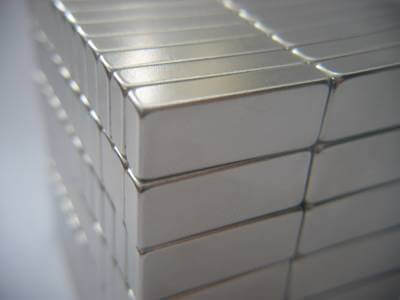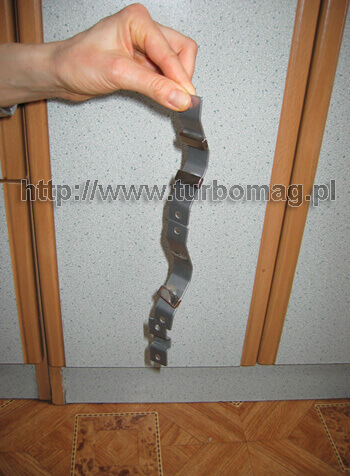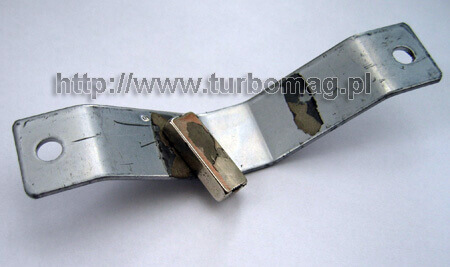FAQ - Turbomag® Magnetizers
Here you will find all the questions regarding magnetizers
On the market, you can find many types of magnetizers. Each of them has a metal mounting clamp. Due to the fact that these clamps disperse the magnetic field, the saturation effect cannot be observed. Additionally, attention should be paid to:
- the material of the magnets - every manufacturer uses the cheapest (i.e., weakest) magnets, usually N35 or N27 - no one can distinguish this with the naked eye,
- the size of the magnet - whether it is a flat magnet 12.5*12.5*5 or an optimal one 25*10*5.
In our magnetizers, we use N38H magnets, which are slightly more expensive (maximum working temperature up to 120°C). In our magnetic lenses, the magnetic field is collected from the opposite pole to prevent it from escaping onto the metal plate (i.e., the mounting clamp).

The filter has a circular shape, so the magnetic field is enclosed within the circle and cannot "escape," while also maintaining the so-called flow continuity.
Metal plates, on the other hand, have sharp ends and usually do not touch each other, resulting in the field not being enclosed or unnecessarily accumulating at the end of the plate instead of on the opposite side of the magnet - the magnetic lens.
It is also worth noting that the metal used for filters is ferromagnetic, which means that over time, the magnetic field acting on the filter turns it into a magnetizer (OR MAYBE MAGNET?). This can be easily verified by applying small metal filings, pins, etc., to a used filter.

Understanding this issue requires knowledge of engine construction. Anyone who has ever changed oil in an engine knows that the oil plug contains a magnet. We are the only ones on the market to offer an oil magnetizer. Its purpose is not only to clean the oil system from ferromagnetics but also to ionize the oil ester to make it adhere better to the engine (reducing friction). However, the oil plug in the engine contains a very weak ALNICO magnet, which does not catch everything it should.
In addition, the ALNICO magnet is much weaker than a neodymium magnet, which means that the ionization process of the ester is not significant.

NO! No transitional periods or miles driven are needed here. Magnetizers exert a constant magnetic field (they are not charged after driving 1000 km) on fuel and oil esters, and the effect is visible immediately upon installation. Only in the case of oil magnetizers, the full effect requires a short wait, which involves pumping the oil through the oil filter at least 30 times.
The construction of Turbomag® magnetizers significantly differs from competing products. The main differentiating features are:
- plastic clamps
- magnets are not glued but held mainly on the clamps, adhering to the magnetic lens over a large surface area
- clamps are not heavy
This innovative design was developed with the poor condition of Polish roads in mind. Thanks to this solution, users of Turbomag® magnetizers are not exposed to the danger of losing a magnet that could detach from the clamp while driving.
In addition, when a magnet detaches, attached to the clamp (and not Turbomag®!), due to its own weight, it peels off the protective nickel coating from its surface, which protects it from internal corrosion and loss of magnetic properties.

Cars with diesel engines are more fuel-efficient than those with gasoline engines or LPG installations. However, diesel fuel is much denser, so to achieve a satisfactory effect, the magnets on the filter must be slightly larger than in gasoline installations.
NO! The magnetic process occurs instantaneously, but this does not mean that magnetism immediately "escapes." Examples of this are the latest generation oils from the Magnatec series, which act similarly to magnets by adhering to surfaces and reducing friction. The magnetization of the oil is a momentary process, after which the oil retains its magnetic properties for a long time. The same applies to the magnetization of fuel or oil dipoles during the combustion process. Additionally, over time, the filters on which the magnetizers are installed themselves become magnetizers, as the metal walls accumulate magnetic charges.
Unfortunately, the variety of car models makes it impossible to standardize the diameter of the air duct. And in a situation where precision matters, it may initially seem that there is nothing else to do but design a different mounting clamp for each car brand. However, this problem has been circumvented by precisely setting the magnetizers at the correct angle without cutting or bending identical clamps.
Remember - magnets are not batteries! In this case, bigger does not mean better. Theoretically, it would be possible to construct a magnetizer using ferrite magnets, but they would have to be ten times larger to achieve the same power as using neodymium magnets in a magnetizer. The latter are composed of various-density sintered materials (iron-neodymium-boron), and "N38" is the designation for material quality, indicating that a given N38 magnet can hold 38 kg, while, for example, an N35 magnet can hold 35 kg. The N38 magnets used in magnetizers are optimal for the intended purpose of the device. Selecting much more expensive magnets with greater strength will not significantly improve the performance of the magnetizer.
The symbol H indicates the ability to function properly even at temperatures up to 120°C. In other words, the magnets do not lose their magnetic properties if, for example, the engine overheats or the oil filter heats up during operation.
- reduced emissions of CO, hydrocarbons, and NO x (up to 50%)
- reduced fuel consumption (up to 22% - realistically 0.83-1.74 liters/100km)*
- thorough cleaning of the fuel-oil system from ferromagnetics**
- achieving significantly higher engine performance with poor fuel quality - increased power and flexibility
- improved operation of carburetors and fuel injectors - quieter operation, better combustion
- easy start-up in any conditions
- significantly extended engine life
* applies to vehicles with engine capacities up to 1.2 liters and the latest CRDI - Diesel engines
** magnetizers must be installed on filters to allow the cleaning of the system from ferromagnetic impurities during filter replacement, which remain in the filters thanks to the use of magnetizers.

